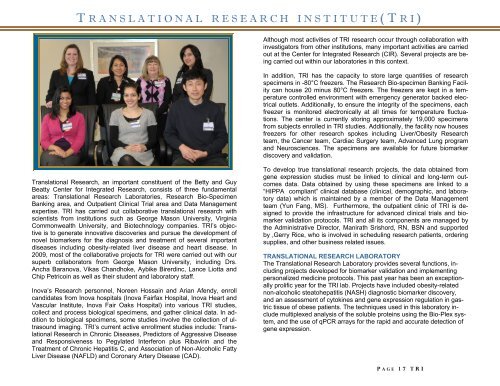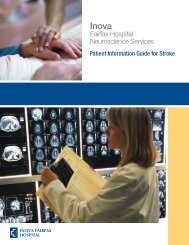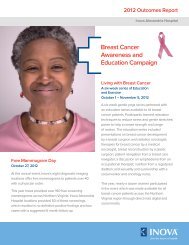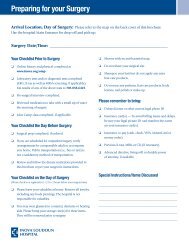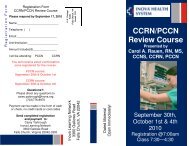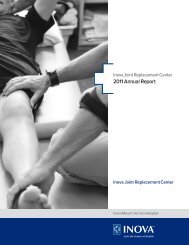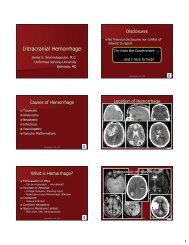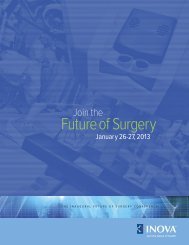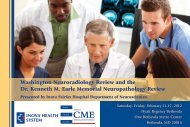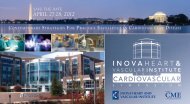betty and guy beatty center for integrated - Inova Health System
betty and guy beatty center for integrated - Inova Health System
betty and guy beatty center for integrated - Inova Health System
Create successful ePaper yourself
Turn your PDF publications into a flip-book with our unique Google optimized e-Paper software.
T RANSLATIONAL RESEARCH INSTITUTE(TRI)<br />
Although most activities of TRI research occur through collaboration with<br />
investigators from other institutions, many important activities are carried<br />
out at the Center <strong>for</strong> Integrated Research (CIR). Several projects are being<br />
carried out within our laboratories in this context.<br />
In addition, TRI has the capacity to store large quantities of research<br />
specimens in -�������������������������������<br />
-specimen Banking Facil-<br />
����������������������� ��������������������������<br />
perature controlled environment with emergency generator backed electrical<br />
outlets. Additionally, to ensure the integrity of the specimens, each<br />
freezer is monitored electronically at all times <strong>for</strong> temperature fluctuations.<br />
The <strong>center</strong> is currently storing approximately 19,000 specimens<br />
from subjects enrolled in TRI studies. Additionally, the facility now houses<br />
freezers <strong>for</strong> other research spokes including Liver/Obesity Research<br />
team, the Cancer team, Cardiac Surgery team, Advanced Lung program<br />
<strong>and</strong> Neurosciences. The specimens are available <strong>for</strong> future biomarker<br />
discovery <strong>and</strong> validation.<br />
To develop true translational research projects, the data obtained from<br />
gene expression studies must be linked to clinical <strong>and</strong> long-term out-<br />
Translational Research, an important constituent of the Betty <strong>and</strong> Guy comes data. Data obtained by using these specimens are linked to a<br />
Beatty Center <strong>for</strong> Integrated Research, consists of three fundamental ���������������������������������������������������<br />
areas: Translational Research Laboratories, Research Bio-Specimen tory data) which is maintained by a member of the Data Management<br />
Banking area, <strong>and</strong> Outpatient Clinical Trial area <strong>and</strong> Data Management team (Yun Fang, MS). Furthermore, the outpatient clinic of TRI is de-<br />
expertise. TRI has carried out collaborative translational research with signed to provide the infrastructure <strong>for</strong> advanced clinical trials <strong>and</strong> bio-<br />
scientists from institutions such as George Mason University, Virginia marker validation protocols. TRI <strong>and</strong> all its components are managed by<br />
������������� ������������ ���� �������������� ����������� the Administrative ������Director, ������Manirath<br />
Srishord, RN, BSN <strong>and</strong> supported<br />
tive is to generate innovative discoveries <strong>and</strong> pursue the development of by ,Gerry Rice, who is involved in scheduling research patients, ordering<br />
novel biomarkers <strong>for</strong> the diagnosis <strong>and</strong> treatment of several important supplies, <strong>and</strong> other business related issues.<br />
diseases including obesity-related liver disease <strong>and</strong> heart disease. In<br />
2009, most of the collaborative projects <strong>for</strong> TRI were carried out with our TRANSLATIONAL RESEARCH LABORATORY<br />
superb collaborators from George Mason University, including Drs. The Translational Research Laboratory provides several functions, in-<br />
Ancha Baranova, Vikas Ch<strong>and</strong>hoke, Aybike Birerdinc, Lance Liotta <strong>and</strong> cluding projects developed <strong>for</strong> biomarker validation <strong>and</strong> implementing<br />
Chip Petricoin as well as their student <strong>and</strong> laboratory staff.<br />
personalized medicine protocols. This past year has been an exceptionally<br />
prolific year <strong>for</strong> the TRI lab. Projects have included obesity-related<br />
�������� ��������� ����������� ������� �������� ���� ������ non-alcoholic �������� steatohepatitis ������� (NASH) diagnostic biomarker discovery,<br />
c<strong>and</strong>idates from <strong>Inova</strong> hospitals (<strong>Inova</strong> Fairfax Hospital, <strong>Inova</strong> Heart <strong>and</strong> <strong>and</strong> an assessment of cytokines <strong>and</strong> gene expression regulation in gas-<br />
Vascular Institute, <strong>Inova</strong> Fair Oaks Hospital) into various TRI studies, tric tissue of obese patients. The techniques used in this laboratory in-<br />
collect <strong>and</strong> process biological specimens, <strong>and</strong> gather clinical data. In adclude multiplexed analysis of the soluble proteins using the Bio-Plex sysdition<br />
to biological specimens, some studies involve the collection of ul- tem, <strong>and</strong> the use of qPCR arrays <strong>for</strong> the rapid <strong>and</strong> accurate detection of<br />
�������������������������������������������������������������������������<br />
gene expression.<br />
lational Research in Chronic Diseases, Predictors of Aggressive Disease<br />
<strong>and</strong> Responsiveness to Pegylated Interferon plus Ribavirin <strong>and</strong> the<br />
Treatment of Chronic Hepatitis C, <strong>and</strong> Association of Non-Alcoholic Fatty<br />
Liver Disease (NAFLD) <strong>and</strong> Coronary Artery Disease (CAD).<br />
P AGE 17 TRI


